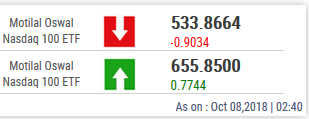I was looking at the price of ICICI500 ETF today and I saw that it was down by 9% while the underlying BSE 500 index is just down by about 1%.

Can someone explain this?
I was looking at the price of ICICI500 ETF today and I saw that it was down by 9% while the underlying BSE 500 index is just down by about 1%.

Can someone explain this?
When it comes to ETFs, you will have to look at 2 things: the NAV and the market price. Since ETFs are listed, the price is what the market is will to pay. The NAV is the per unit value of the underlying assets.
In this case, the price of the ETF kept rising while the index itself was falling. So, today the value has reverted back to a price that is closer to the NAV.
Here’s the price vs the index. Notice the highlighted part. The price of the ETF kept going up while the Index was falling.
How does the price adjust?
ETFs, appoint market makers to provide liquidity. When the price of an ETF goes up, the market maker will deposit the underlying shares of the ETF for which in exchange he’ll receive the units of the ETFs, which he’ll seel in the market. This will bring down the price of the ETF back to a fair level and he pockets the difference between the price and NAV.
Why the difference in price?
Except for a few Nifty 50 ETFs, almost all the other Indian ETFs are highly illiquid. Small volumes can move the prices of the ETFs. If you look at the volume bars in the image above, you’ll hardly see any.
This isn’t the only ETF where this happens. The difference in price and NAV of the N100 Motilal ETF is much starker. The ETF tracks the Nasdaq 100 Index and the difference between the price and NAV is Rs 122

Ideally, when you are buying ETFs, it’s always wise to check the difference between NAV and the price. You can check the NAV of the ETF on the respective AMC sites.
We are working on it. ![]()